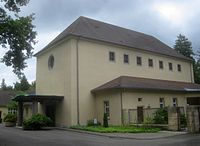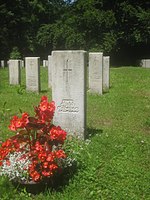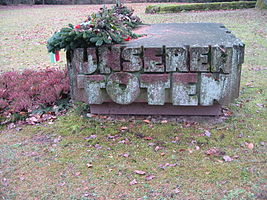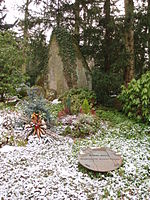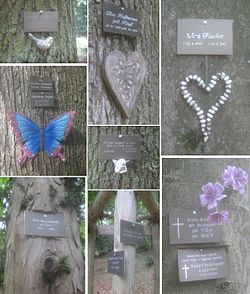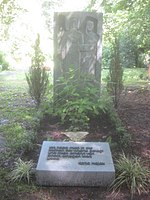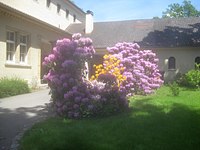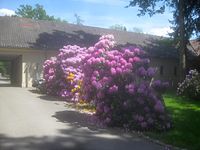Forest cemetery Stuttgart

The Stuttgart Forest Cemetery was laid out in 1913, shortly before the outbreak of the First World War, according to the plans of the Stuttgart City Planning Director Albert Pantle . Numerous celebrities are buried in the cemetery, which is located in the Degerloch district of Stuttgart . The name of the cemetery refers to the fact that it was built in the middle of the mixed forest of the Degerloch forest.
The cemetery consists of two parts:
- the older and larger western main part
- and the younger Waldfriedhof-Viereichenhau to the east.
With 30.7 hectares it is the largest in terms of area and, with its 15,000 grave sites, the third largest in Stuttgart. It is divided into divisions 1-35 (main part) and 50-75 (Viereichenhau).
On the cemetery area there is a celebration hall, an administration building, a morgue and three cenotaphs for those who died in the two world wars. The Dornhaldenfriedhof , which was laid out in 1974, is located further to the east and is adjacent to the cemetery .
A funicular from 1929 connects Südheimer Platz with the cemetery 100 meters higher.
graveyard
David Koch, the Stuttgart pastor and editor of the Christian Art Journal for Church, School and House , dealt with the Stuttgart forest cemetery in a critical report in 1917, in which he also discussed the general layout of the cemetery:
- “The forest cemetery of the city of Stuttgart is laid out on an almost horizontal terrace in the woods that stretch up from the southern end of Stuttgart towards the Filder Plain, the construction of which was created under the impression of the ideal Munich forest cemetery , proof that the Munich complex was so completely immediate it was set as a generally valid model that no cemetery architect can escape this model. "
building
The cemetery buildings at the main entrance were built in 1914 according to the plans of the Stuttgart City Planning Director Albert Pantle , who is also buried in the cemetery (see here ). In addition to numerous public buildings, including many schools, Stuttgart also owes Albert Pantle other cemetery buildings in the Bergfriedhof and Untertürkheim cemetery.
The building complex consists of the following buildings (see detailed plan of the forest cemetery ):
- Celebration hall, also known as the funeral hall or chapel, house number 2 in the detailed plan
- Mortuary and administration building, number 3
- Company building, house number 4
- Residential building (former supervisor's house), house number 1
- Tool shed, house number 5, between department 30b and 4d
The main entrance is between the residential building and the celebration hall. It is closed by a lattice gate and two side lattice doors. The gate is flanked by two posts with the reliefs of mourners (artist unknown). A side entrance leads through the connecting building between the celebration hall and the administration building into the cemetery. Opposite this entrance is the western entrance of the Waldfriedhof-Viereichenhau, the eastern entrance joins the Heinestrasse.
The central building is the hipped roof-covered celebration hall, which towers above the otherwise one-story building by floor height. The portico at the front rests on two granite columns ( Rosa Sardo ) and ends with a curved bronze roof. A two-winged brass gate leads to a basilica- like hall with a flat, coffered wooden ceiling. Behind the gate you step under the organ , which is illuminated through a round stained glass window (artist unknown).
The organ was built in 1956 by the organ building company Walcker-Orgelbau , which at that time was based in nearby Ludwigsburg . Walter Supper took care of the sound design and the design of the organ front (front side of the organ) .
At the other end of the hall is the apse , into which a large arched niche with a mosaic of the risen Jesus by Rudolf Yelin is embedded.
On the two long sides and the back of the celebration hall leans a single-storey, continuous extension with wide, open pillared porches drawn into the facade. Between the pairs of columns in the back porch there is a fountain with the Egyptian-style black copper sculpture "The Virgin with the Cups of Tears" by Josef Zeitler from 1914 (see cover picture ). The water trickles drop by drop from the two bowls that the sculpture holds up into the round fountain basin. An inscription next to the fountain says: "Every drop is also a dying human life".
The main entrance and the unplastered parts of the celebration hall are made of Cannstatt travertine , a yellow-brown to ocher-colored, very weather-resistant stone.
War graves and memorials
The Great Meadow begins behind the celebration hall, a grass-covered area the size of a football field (approx. 130 m × 65 m), which is lined with trees in a U-shape (see detailed plan of the forest cemetery ) and the entire layout of which was designed by Martin Elsaesser . In the center of the rear quarter of the large meadow there is a tall, stone crucifix designed by Max Natter, executed by Richard Schönfeld and erected in 1916 during the First World War.
To the left of the Große Wiese, between divisions 1 and 20, two main paths lead to the three war cemetery fields of the forest cemetery:
- Field of aviation casualties for the victims of the Second World War with a memorial for the victims of the air raid of September 5, 1918
- Grave field with the memorial for the fallen participants of the First World War
- Grave field with the memorial for the fallen and victims of the Second World War
Field of casualties
The grave field of the aviation victims of the Second World War occupies the departments 2b and 2c (see detailed plan of the forest cemetery ). It begins behind the Großer Wiese with Max Natter's high cross and lies in front of the memorial for the fallen participants in the First World War.
482 of the 4562 air war victims who lost their lives in air raids on Stuttgart from 1943 to 1945 were buried here . While the number of aerial warfare victims was 45 up to 1942, the air raids in 1943 alone claimed almost 1,000 victims, so the city decided to build the field of aviation victims.
Simple limestone steles with an engraved cross and the name and year of birth and death of the deceased commemorate the victims of the aerial warfare . Two tombs are dedicated to house communities that were wiped out in an air raid. In this case, the address of the house is on the stele, the dates of the deceased housemates are recorded on a stone.
Cenotaph for the victims of the air raid on September 5, 1918
In the far corner of Section 2b is a memorial dedicated to the victims of the air raid on September 5, 1918. A high stele bears a round medallion with a relief of a falling plane and below the inscription:
- "Erected by the city of Stuttgart in memory of the victims of the enemy attack on September 5, 1918"
In front of the stele there are ten slab graves of the victims of the air raid in two rows.
Cenotaph for the fallen participants in the First World War
The memorial in Division 3, surrounded by war graves in a fan shape, was laid out in 1923 as an honorary grove (or heroes' grove) with a church-like floor plan according to the plans of Paul Bonatz , who also found his final resting place in the forest cemetery. The tree-lined grove of honor has the shape of a rectangle that ends with a semicircle (about 46 × 20 meters). The surrounding 1300 war graves bear simple, uniform grave crosses made of red sandstone.
The rectangular part of the grove of honor ends on a slightly raised platform with the altar area, which is enclosed by three shoulder-high walls in a U-shape and can be accessed on both sides via a three-step staircase. The walls are lined with five memorial plaques with low stone benches, and a bronze high cross has been erected in front of the rear wall. At the front edge of the altar area there is an altar table ( canteen ). On the front it bears a large relief of the Iron Cross and the dates 1914 and 1918, and the side walls bear the three stag poles of the Württemberg coat of arms . The face of the altar panel is lined with the inscription: "In memory / the eight thousand five hundred fallen / as a pledge of loyalty / the citizens of the city of Stuttgart". Of the 8,500 fallen, only about 1,300 were buried in the honor grove.
The altar area is adjoined by two lawn-covered areas (similar to side altars), with a memorial obelisk in the middle and a boundary wall interrupted by an entrance, each with two memorial plaques.
The main path runs in front of the altar area and continues to the memorial for the fallen and victims of the Second World War. The apse - like semicircle opposite the altar area is bordered by a low wall, in front of which four memorial obelisks are lined up. The non-fenced space between the altar area and the semicircle is flanked on each side by four large memorial steles . In the center of the semicircle is the large sculpture "Mother Homeland". The Pietà -like shell limestone sculpture was started by Fritz von Graevenitz in 1932 and branded by the Nazis as an “intolerable Christian Pietà”. It was completed in 1953 and installed in its current location in 1957.
Altar table, memorial plaques, memorial obelisks and memorial steles are made of Cannstatt travertine , a yellow-brown to ocher-colored, very weather-resistant stone. The walls of the fence are made of yellow and red sandstone.
During the Second World War, the cemetery was badly damaged in March 1943. The two historical photos from 1924 show grave crosses with a roof or in the form of iron crosses from the field of honor for the fallen of the First World War, who also fell victim to the destruction.
Cenotaph for the fallen and victims of the Second World War
If you cross the memorial for the fallen participants in the First World War, you will find the memorial for the fallen and victims of the Second World War in section 32 (see detailed plan of the forest cemetery ). The transverse, grass-covered grove of honor has the same floor plan as the memorial of the First World War: a rectangle that ends with a semicircle (approx. 48 × 20 meters). The grove is surrounded by a J-shaped, low natural stone wall to which the burial grounds adjoin. The lawn of the grove of honor continues on the left long side. There are no graves in this open field, perhaps a symbolic place for the many fallen in foreign soil.
Instead of building another “holy temple area” as for the victims of the First World War, it was decided to use an unspectacular memorial sign without pathos, which in its simplicity corresponds to the speechlessness before the incredible horror of the Second World War. In the semicircle area there is a low, table-like cuboid made of red sandstone, which is similar to the altar table on the Bonatz Memorial. The memorial stone was designed by Eva Zippel and executed in 1979 by Jörg Failmezger . It bears the succinct, block-like inscription on the four faces:
- "Our Dead - 1939 - Our Dead - 1945".
Celebrity graves
Of the Stuttgart cemeteries, the forest cemetery has the largest share of celebrity graves from the recent past. Most of these graves are concentrated in sections 1 and 20 (see detailed plan of the forest cemetery ). The graves are lined up along two paths that lead from the administration building to the left of the Great Meadow with Max Natter's crucifix. The celebrity graves differ from most other graves in their comparatively oversized size, while the tombs are mostly simple and reserved.
Some of the most famous graves are:
- The grave of Theodor Heuss , the first Federal President of the Federal Republic of Germany, and of Elly Heuss-Knapp , his wife.
- The graves of Stuttgart's Lord Mayor Karl Lautenschlager (last Lord Mayor before the Nazi era) and Arnulf Klett (first Lord Mayor after the Second World War).
- The graves of the politicians Walter Hallstein (first chairman of the Commission of the European Economic Community ), Erwin Schoettle (important SPD politician, resistance fighter in the Third Reich) and Gebhard Müller ( President of Württemberg-Hohenzollern , Prime Minister of Baden-Württemberg , President of the Federal Constitutional Court ).
- The graves of the entrepreneurs Gottlob Bauknecht , Robert Bosch and Eduard Breuninger .
There are also two anonymous graves between the celebrity graves:
- Next to the grave of Robert Bosch there is a grave with the inscription “Neither death nor life can separate us from the love of God that is in Christ Jesus” ( Paul’s letter to Romans 8 : 38-39).
- Department 20b begins with a modern and architecturally designed, as yet unoccupied grave, which an architect had built for himself according to his own plans.
A number of artists, some of local importance, some of national and international reputation, are also buried in the forest cemetery, including the following people:
- Sculpture: Hans Dieter Bohnet , Jakob Brüllmann , Otto Herbert Hajek , Josef Zeitler
- Painting: Adolf Hölzel , Ida Kerkovius , Oskar Schlemmer
- Architecture: Paul Bonatz , Ludwig Eisenlohr , Fritz Leonhardt , Albert Pantle
- Writers: Klaus Mehnert , Friedrich Sieburg
- Film and television: Michael Pflegehar , Fritz Umgelter
- Singing art: Sigrid Onégin , Wolfgang Windgassen , Marcel Wittrisch
Anyone who expects tombs that correspond to the significance of the respective artist will be disappointed. Almost all of these graves are kept very simple and unadorned (except for the graves of Brüllmann, Hajek, Pantle and Zeitler).
Tree diggers
The forest cemetery is one of the cemeteries in Stuttgart where "tree graves" (official name) are allowed. The ashes urns of the deceased are buried in the immediate vicinity of a tree. The relatives can have uniform tablets (10 cm × 6 cm) with names, dates of birth and death and a religious symbol attached to the tree. Many relatives clip a flower or a bouquet of flowers to the tag or attach small reminder signs such as butterflies, birds, hearts or angels.
Tree graves are currently located in the main part of the forest cemetery in sections 34 and 35 and in the forest cemetery-Viereichenhau in section 60.
Otto Herbert Hajek
The Stuttgart sculptor Otto Herbert Hajek , whose works one encounters at every step in Stuttgart, also left his mark on and on the forest cemetery.
Large room relief
At the end of Eugen-Dolmetsch-Strasse, across from the car park, a large work by Hajek, the “Large Relief”, is on display at the corner of the Waldfriedhof-Viereichenhau (eastern part of the cemetery).
The "large room relief" made of modeling concrete measures 240 cm × 530 cm × 60 cm and is signed on the lower right with "HAJEK". The heavy weight of the relief is held in a vertical position at the rear by a support structure made of thick structural steel. The work was created in 1962, a time in which Hajek developed several large spatial reliefs: "Magnetisches Raumfeld", University of Freiburg (1959), "Spatial Wall", Villingen (1959), "Leitwand", Frankfurt am Main (1962), Kreuzweg, Berlin-Plötzensee (1963), chancel with room reliefs, Mannheim (1963). Hajek took part in documenta II in 1959 with two “Raumknoten” and with the walk-in sculpture “Frankfurter Frühling” at documenta III 1964. In addition to its participation in the 1958 Venice Biennale, the “Frankfurter Frühling” in particular played a key role in the international breakthrough of Hajek.
In 2008 the city of Stuttgart had the large relief that the artist bequeathed to the city set up in front of the forest cemetery, where he found his final resting place in 2005.
Hajek's graves and wife
The main part of the cemetery also contains the graves of Otto Herbert Hajek, who died in 2005, and his wife, the writer Katja Hajek, who died in 2011. They are not buried in a common grave; their two graves are opposite one another. A statue on Katja Hajek's grave (section 14 b) shows the relief of a couple (artist: OH Hajek, Muschelkalkstein, catalog raisonné A12), and on a rock there is a short poem by her: “I am in the / flowers of the wilderness laid / And feeds me on / One single word / Love. "
On Hajek's grave (section 14 d) there is one of several versions of the bronze sculpture “Stadtzeichen K III” from 1990 (135 × 59 × 59 cm) that he designed and made. The pedestal was created by the Hajek student Andreas Helmling . Behind the tomb stands Hajek's “Large Sculpture”, a bronze sculpture from 1962 (420 × 130 × 125 cm, catalog raisonné 184b), which is one of his works that he describes as “spatial layers”.
Graves
Note: In the cemetery guide by Werner and Christopher Koch ( #Koch 2012 ) and in the SSB brochure "Lebenslinien" ( # Straßenbahnen 2009 ) there are short biographies of celebrities who are buried in the forest cemetery, a map with location information for graves and monuments and photos of the graves in the cemetery guide.
| → Column legend and sorting | ||||||||||
| Legend | ||||||||||
|
||||||||||
| Sorting | ||||||||||
| image | # | P | K | dig | * | † | Artist / object |
|---|---|---|---|---|---|---|---|
| 06 h | P | Erwin Baelz , personal physician to the Japanese imperial family. | 1849 | 1913 | |||
| 20 a | P | Gottlob Bauknecht , founder of Bauknecht Hausgeräte GmbH. | 1892 | 1976 | |||
| 14 a | P | K | Heinrich Beck , publisher. | 1853 | 1914 | Stone sculpture, mourning guardian angel with urn and wreath. | |
| 09 a | P | K | Karl Bleyle , composer. | 1880 | 1969 | Stone relief, kneeling mother with a naked child. | |
| 16 b | P | Hans Dieter Bohnet , sculptor. | 1926 | 2006 | |||
| 24 hours | P | Paul Bonatz , architect. | 1877 | 1956 | |||
| 01 c | P | Robert Bosch , founder of Robert Bosch GmbH . | 1861 | 1942 | |||
| 01 c | P | Eduard Breuninger , founder of the Breuninger department stores. | 1854 | 1932 | |||
| 09 d | P | K | Jakob Brüllmann , sculptor. | 1872 | 1938 | Jakob Brüllmann: Lying deer. | |
| 10 c | P | Carl Dinkelacker, founder of the Dinkelacker brewery . | 1862 | 1934 | |||
| 02 a | P | Ludwig Eisenlohr , architect. - Tomb no longer exists, memorial plaque planned. | 1851 | 1931 | |||
| ? | P | Georg Fahrbach , chairman of the Swabian Alb Association . | 1903 | 1976 | |||
| 09 h | P | Hans Fein , operations manager of C. & E. Fein GmbH, grandson of Wilhelm Emil Fein , the inventor of the hand-held electric drill. | 1899 | 1969 | |||
| 09 h | P | K | Wilhelm Gessler , Württemberg Minister of Finance. | 1850 | 1925 | Stele with urn in a temple made of four pillars with a roof. | |
| 06 o | K | Paul Haag, pharmacist. | 1868 | 1919 | Bronze statue, standing mourners with wreaths, leaning against a stone stele with urn. | ||
| 14 b | P | K | Katja Hajek, writer, wife of Otto Herbert Hajek . | 1921 | 2011 | Relief of a couple. By Otto Herbert Hajek (WV: A 12, shell limestone) | |
| 14 d | P | K | Otto Herbert Hajek , sculptor, tomb. | 1927 | 2005 | Otto Herbert Hajek : City Sign K III (1990) (WV: P 616) | |
| 14 d | P | K | Otto Herbert Hajek , sculptor, bronze sculpture behind his grave. | 1927 | 2005 | Otto Herbert Hajek: Large Sculpture (1962) (WV P 184 b) | |
| 20 b | P | K | Walter Hallstein , first chairman of the Commission of the European Economic Community . | 1901 | 1982 | Red sandstone stele, cube pedestal, column with climbing vines, on top of it a tower-like house with reliefs on the sides. | |
| 16 a | P | Claire Heliot , animal trainer . | 1866 | 1953 | Two lion figures. | ||
| 01 c | P | Theodor Heuss , first Federal President of the Federal Republic of Germany. | 1884 | 1963 | |||
| 01 c | P | Elly Heuss-Knapp , politician, wife of Theodor Heuss. | 1881 | 1952 | |||
| 04 d | P | Johannes von Hieber , President of Württemberg . | 1862 | 1951 | |||
| 09 a | P | Wolf Hirth , glider pioneer, first president of the German Aero Club after the Second World War. | 1900 | 1959 | |||
| 20 b | P | Karl Hofmeister , President of the Württemberg-Hohenzollern and Württemberg-Baden Court of Auditors . | 1886 | 1972 | |||
| 15 l | P | Adolf Hölzel , painter. | 1853 | 1934 | |||
| 04 a | K | Ernst Hory, Oberamtmann, died in 1914, first occupied grave in the forest cemetery. | 1870 | 1914 | |||
| 14 f2 | P | Willi Hoss , trade unionist and politician. | 1929 | 2003 | |||
| 06 o | K | Eugene Kentner. | 1863 | 1930 | Bronze statue, hammer-bearer with a naked torso in antique robe. | ||
| 16 b | P | Ida Kerkovius , painter. | 1879 | 1970 | |||
| 01 a | P | Arnulf Klett , Lord Mayor of Stuttgart. | 1905 | 1974 | |||
| 10 n | P | August Koehler , painter | 1881 | 1964 | |||
| 09 a | P | Otto Konz , hydraulic engineer, creator of the Neckar Canal . | 1875 | 1965 | |||
| 14 n | P | Rudolf Kreitlein , football referee . | 1919 | 2012 | |||
| 15th | P | Hellmuth Laegeler , Major General of the Wehrmacht and the Bundeswehr. | 1902 | 1972 | |||
| 10 c | P | August Lämmle , Swabian dialect poet. | 1876 | 1962 | |||
|
|
? | P | Christian Landenberger , painter. | 1862 | 1927 | ||
| 01 a | P | K | Carl Lautenschlager , Lord Mayor of Stuttgart. | 1868 | 1952 | Outline drawing of a jumping horse (Stuttgart heraldic animal). | |
| 14 f2 | P | Fritz Leonhardt , civil engineer, builder of the Stuttgart television tower , the first television tower in reinforced concrete. | 1909 | 1999 | |||
| 05 e | P | Hedwig Lohß , writer. Grave inscription: Hedwig Staiger b. Lohss. | 1892 | 1986 | Family grave with a wooden cross. | ||
| 54 a | P | Theodor Loos , actor. | 1883 | 1954 | |||
| 06 d | P | Paul von Maur jun., Freight forwarder. | 1864 | 1915 | |||
| 21 a | P | Klaus Mehnert , political journalist. | 1906 | 1984 | |||
| 20 b | K | Christian Mergenthaler , Prime Minister of Württemberg during the Nazi era . | 1884 | 1980 | Fritz von Graevenitz: stone sculpture, standing mourners. | ||
| 05 c | K | Nela Merz. | Sculpture, decorated Indian elephant. | ||||
| 20 b | P | Gebhard Müller , President of Württemberg-Hohenzollern , Prime Minister of Baden-Württemberg , President of the Federal Constitutional Court . | 1900 | 1990 | |||
| 07 c | P | Sigrid Onégin , opera and concert singer. | 1889 | 1943 | |||
|
|
04 a | P | K | Albert Pantle , architect. | 1859 | 1921 | Josef Zeitler : Two putti with a rose garland, shell limestone. |
| 05 b | P | Carl Anton Pfeiffer , piano manufacturer. | 1861 | 1927 | |||
| 11 d | P | Michael Pflegehar , film director and television producer. | 1933 | 1991 | |||
| 02 a | P | Theodor von Pistorius , Minister of Finance of Württemberg. | 1861 | 1939 | |||
| 14 q | Erich Ponto , actor. Memorial stone on the grave of the Alfred Böhm family. - Erich Ponto was originally buried in the forest cemetery in Stuttgart, but later reburied in a cemetery in Hamburg or Tolkewitz . | 1884 | 1957 | ||||
| 05 c | K | Anton Richter. | 1880 | 1940 | Metal sculpture, Mary with the child in the mandorla . | ||
| 10 n | P | K | Walter Romberg , painter. | 1898 | 1973 | Grave stele with bronze portrait of Walter Romberg. | |
| 05 c | K | Karl H. Schäfer-Kunz, business graduate. | 1931 | 2011 | Gravel field. | ||
| ? | P | Erich Schairer , journalist. | 1887 | 1956 | |||
| - | Cläre Schimmel , radio play director. The grave was cleared in 2001. | 1902 | 1986 | ||||
| 14 f2 | P | Oskar Schlemmer , painter. | 1888 | 1943 | |||
| 14 f2 | P | Tut Schlemmer, economist, wife of Oskar Schlemmer. | 1890 | 1987 | |||
| 20 b | P | Helene Schoettle , Stuttgart local politician. | 1903 | 1994 | |||
| 20 b | P | Erwin Schoettle , politician, resistance fighter in exile against National Socialism . | 1899 | 1976 | |||
| ? | P | Adelheid Seeck , actress. | 1912 | 1973 | |||
| 02 a | P | Friedrich Sieburg , writer. | 1893 | 1964 | |||
| 05 c | P | K | Ernst Staengel , chocolate manufacturer ( Eszet chocolate). | 1827 | 1915 | Seated mourners made of red sandstone. | |
| 09 h | P | Eugen Steigleder , architect. | 1876 | 1941 | |||
| ? | P | Bernd Steinacher , Regional Director of the Stuttgart Region Association . | 1956 | 2008 | |||
| 06 o | P | Karl Strölin , Lord Mayor of Stuttgart during the Nazi era . | 1890 | 1963 | |||
| ? | K | Wilhelm Julius Devil. | Bronze figure of a naked reclining man on a stone base by Ludwig Habich . | ||||
| ? | P | Helmuth Uhrig , sculptor. | 1906 | 1979 | |||
| 10 i | P | Fritz Umgelter , film and television director. | 1922 | 1981 | |||
| ? | P | Wilhelm von Urach , mechanical engineer. | 1897 | 1957 | |||
| 54 d | K | Beate and Werner Utz. | 1949 | 2013 | Tree trunk made into a stylized angel with arms raised. | ||
| 30 b | P | Alfred Weidenmann , director and author of books for young people. | 1918 | 2000 | |||
| ? | P | Gerhard Wilhelm , choirmaster of the Stuttgart Hymn Choirboys . | 1918 | 2009 | |||
| 01 a | P | Wolfgang Windgassen , opera singer. | 1914 | 1974 | |||
| 01 c | P | Marcel Wittrisch , chamber singer. | 1903 | 1955 | |||
| 14 r | P | Theophil Wurm , regional bishop of the Evangelical Church in Württemberg . | 1868 | 1953 | |||
| 10 n | P | K | Josef Zeitler , sculptor. | 1871 | 1958 | Stele with a bronze relief with the life data of Josef Zeitler, his portrait and four corner figures. See: Josef Zeitler, tomb . |
Rhododendron bloom
There are hundreds of rhododendron bushes in the forest cemetery, scattered all over the cemetery, but especially in the western main part, which is accessed through the main entrance. In addition to many low individual shrubs, there are quite a few rhododendron bushes twice as high as a man. Sometimes several such almost tree-like bushes stand close together so that they look like a single giant bush, for example at the side entrance to the left of the celebration hall and on the large meadow behind the celebration hall.
In the month of May, the rhododendrons present themselves in a lush blaze of colors of purple and red flower clusters. The rhododendron blossom in the forest cemetery is, wrongly, far less known than the magnolia blossom, which is a main attraction every spring and attracts many visitors to Wilhelma .
literature
General
- Fountain and squadrons in Stuttgart: Virgin with the tear bowls . Stuttgart 2014, online: .
- Dieter Buck; Harald Schukraft: Stuttgart border walks. City history discovery tours. Tübingen 2005, pages 57-58.
- Genres in visual representations. Proceedings of a conference held in 1986 by invitation of the Werner Reimers Foundation in Bad Homburg (Federal Republic of Germany). Leiden 1990, pages 153, 162, 168 (memorial to the fallen veterans of the First World War by Paul Bonatz) online: .
- Alexandra Kaiser: Of heroes and victims. A story of Memorial Day. Campus-Verlag, Frankfurt am Main u. a. 2010, ISBN 978-3-593-39288-2 , pp. 93–97, 105–111 (commemorations for the fallen).
- [David Koch]: The Stuttgart forest cemetery from Oberbaurat Pantle. In: Christian Art Journal for Church, School and House Volume 59, 1917, Pages 210–215, 217–219, 221.
- Werner Koch; Christopher Koch: Stuttgart cemetery guide. A guide to the graves of well-known personalities. Tübingen 2012, pages 86–115.
- Mammut-Verlag (publisher and editor): Stuttgart, Der Friedhofswegweiser. Stuttgart 2011, pages 62-65. - The brochure is available free of charge from the information desk in the town hall.
- Johannes Merz : The Protestant Church Building in Württemberg , Volume 61, 1919, Pages 322–338, here: 338, 357, 358 (crucifix by Max Natter).
- Stuttgarter Straßenbahnen (Ed.): Lifelines. With the Stuttgart cable car to the 1920s - through the decades at the forest cemetery. Stuttgart 2009, online: . - The brochure is available at the cable car .
- 175 years of Walcker organ building. House Notification Number 16, June 1956 , page 71 ( Organ Specifications ), online: .
- Walcker. House Notification Number 18, August 1957 , page 20 ( organ ), online: .
- The forest cemetery in Stuttgart. In: Wasmuth's Monatshefte for architecture and urban Volume 1, 1914-1915, page 442-443, 454-459, online: .
Otto Herbert Hajek
- Hajek plastic set up in Stuttgart. In: art Das Kunstmagazin from October 20, 2008, [2] .
- Monika Bugs: Otto Herbert Hajek in conversation with Monika Bugs. Saarlouis 1998.
- Exhibition cat. Bundeskunsthalle Bonn (Ed.): OH Hajek. A world of signs. with a catalog raisonné by Anuschka Koos. Bonn 2000.
- Otto Herbert Hajek. Sculptures, reliefs, scripts, drawings, lithographs. Haus am Waldsee, Berlin-Zehlendorf, [May - June 1963]. Berlin 1963.
- Claus Pese (editor): OH Hajek. The penetration of life with art. Stuttgart 1987.
- Art in public space. Hajek, Otto Herbert. Stuttgart 2014, [3] .
Auxiliary literature
- Hans Fegers: Rudolf Yelin the Younger. In: Reutlinger Geschichtsblätter New Series, Volume 22, 1983, Pages 7-10, 23-24.
- Wolfgang Hesse: Fritz von Graevenitz '"Mother of Home". Sculptural spirit. In: Karlheinz Fuchs (editor): Exhibition series Stuttgart in the Third Reich. [3]. The seizure of power. From the republican to the brown city. Stuttgart 1983, pages 47-49.
- Erich Heyfelder: Ludwig Habich and his sculpture school at the Stuttgart Art Academy. In: Schwäbisches Heimatbuch , 1935, pp. 53–66.
- Rudolf Pantle: Tomb sculpture for the exhibition for cemetery art in the Hoppenlaufriedhof in Stuttgart. In: Die Plastik Band 4, 1914, pages 60–62, here: 61, plate 80.
- Travertine Park [notice boards and map]. Window into prehistoric times. Stuttgart 2014, especially page 3, online: .
- Gustav Wais: Stuttgart's art and cultural monuments. 25 pictures with city history, architectural history and art history explanations. Stuttgart [1954].
Web links
- Website of the city of Stuttgart, Waldfriedhof .
- Grave fields of aerial warfare victims of both world wars in the forest cemetery .
- Grave fields of the fallen soldiers of both world wars in the forest cemetery .
- Images of the memorial plaques, memorial steles and memorial obelisks of the memorial for the fallen participants in the First World War .
- Topographic map, hybrid map and aerial photos on a scale of 1: 500, city map Stuttgart , search term: Waldfriedhof.
Footnotes
- ↑ #Mammut 2011 , page 64.
- ↑ #Mammut 2011 , page 62.
- ↑ # Koch 1917.3 , page 210.
- ↑ #Walcker 1956 , #Walcker 1957 .
- ↑ #Fegers 1983 , page 23.
- ↑ #Travertinpark 2014 , page 3.
- ↑ #Merz 1919 , #Wais 1954.1 , page 57.
- ↑ #Koch 2012 , page 86, Wikipedia article Air raids on Stuttgart . - In #Koch 2012 the cemetery is mistakenly assigned to the aerial warfare victims of the First World War.
- ^ Sketch of the memorial by Paul Bonatz: #Genres 1990 , page 153.
- ↑ #Koch 2012 , page 86.
- ↑ #Buck 2005 , page 57, #Hesse 1983 , #Koch 2012 , page 86.
- ↑ #Travertinpark 2014 , page 3.
- ↑ #Koch 2012 , page 86.
- ↑ #Koch 2012 , page 86.
- ↑ Overview of the state capital Stuttgart on the types of graves: [1] .
- ↑ A selection of Hajek's works in public space in Stuttgart can be found in #Stuttgart 2014 .
- ↑ Catalog of works P 189 ( #Bundeskunsthalle Bonn 2000 , page 220).
- ↑ Figure see here .
- ↑ Figure see here .
- ↑ #Pese 1987 .
- ↑ Exhibition catalog: II. Documenta '59. Art after 1945 ; Catalog: Volume 2: Sculpture; Kassel / Cologne 1959, p. 236 f.
- ↑ documenta III. International exhibition. Catalog. Volume 1: Painting and Sculpture. Kassel / Cologne 1964, p. 80 f.
- ↑ #Bugs 1998 , page 3.
- ↑ #art 2008 .
- ↑ works P 616 ( #Bundeskunsthalle Bonn 2000 , page 220). - Message from Dr. Chris Gerbing (Hajek estate) of September 22, 2014: “Both sculptures that are on or near Hajek's grave were designed and made by him at different times. The grave design and the base (and exclusively this one!) For the smaller sculpture located directly on the grave was done by Andreas Helmling. The sculpture itself is entitled “Stadtzeichen K III” (1990) (catalog raisonné P 616). Bronze, 135 × 59 × 59 cm. "
- ↑ Catalog raisonné P 184 a ( #Bundeskunsthalle Bonn 2000 , page 220).
- ↑ #Koch 2012 , page 97.
- ↑ #Pantle 1914 , plate 80.
- ↑ # Heyfelder 1935 , page 53.
Coordinates: 48 ° 45 ′ 2.8 " N , 9 ° 8 ′ 44.9" E


